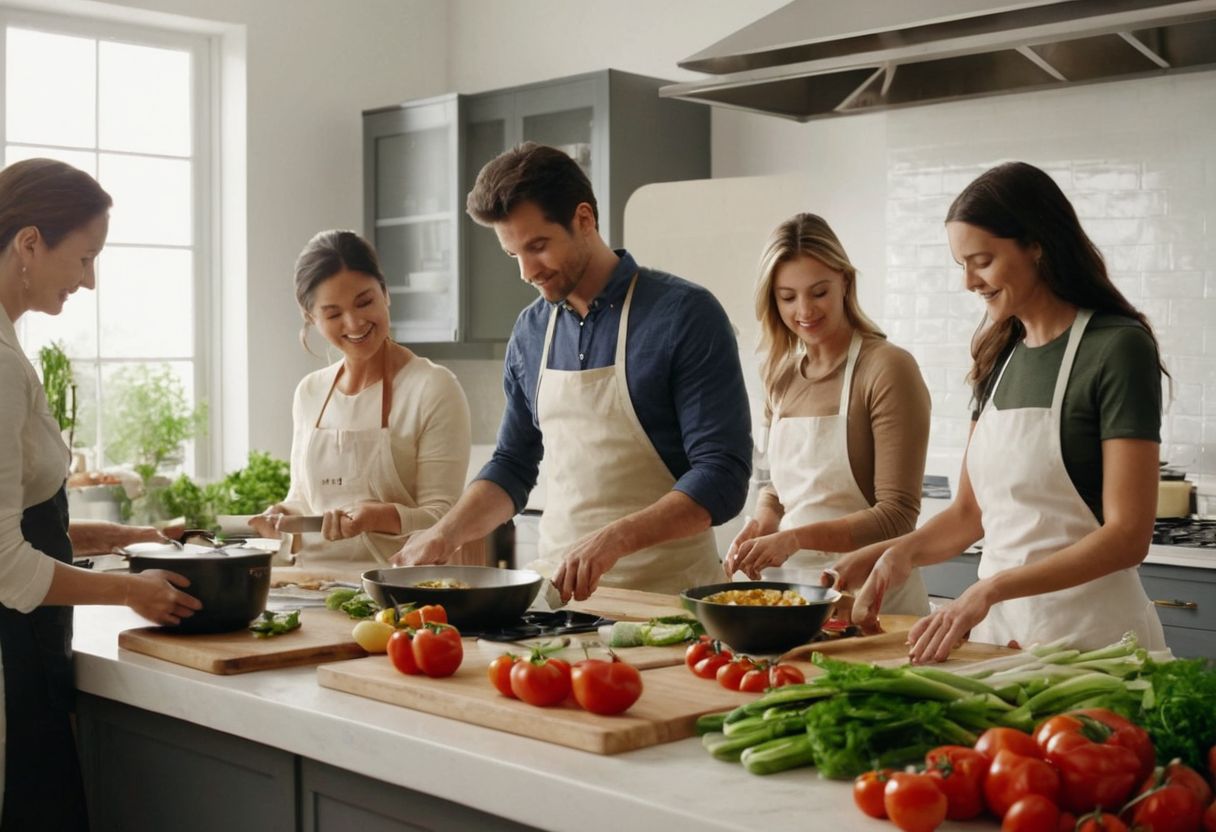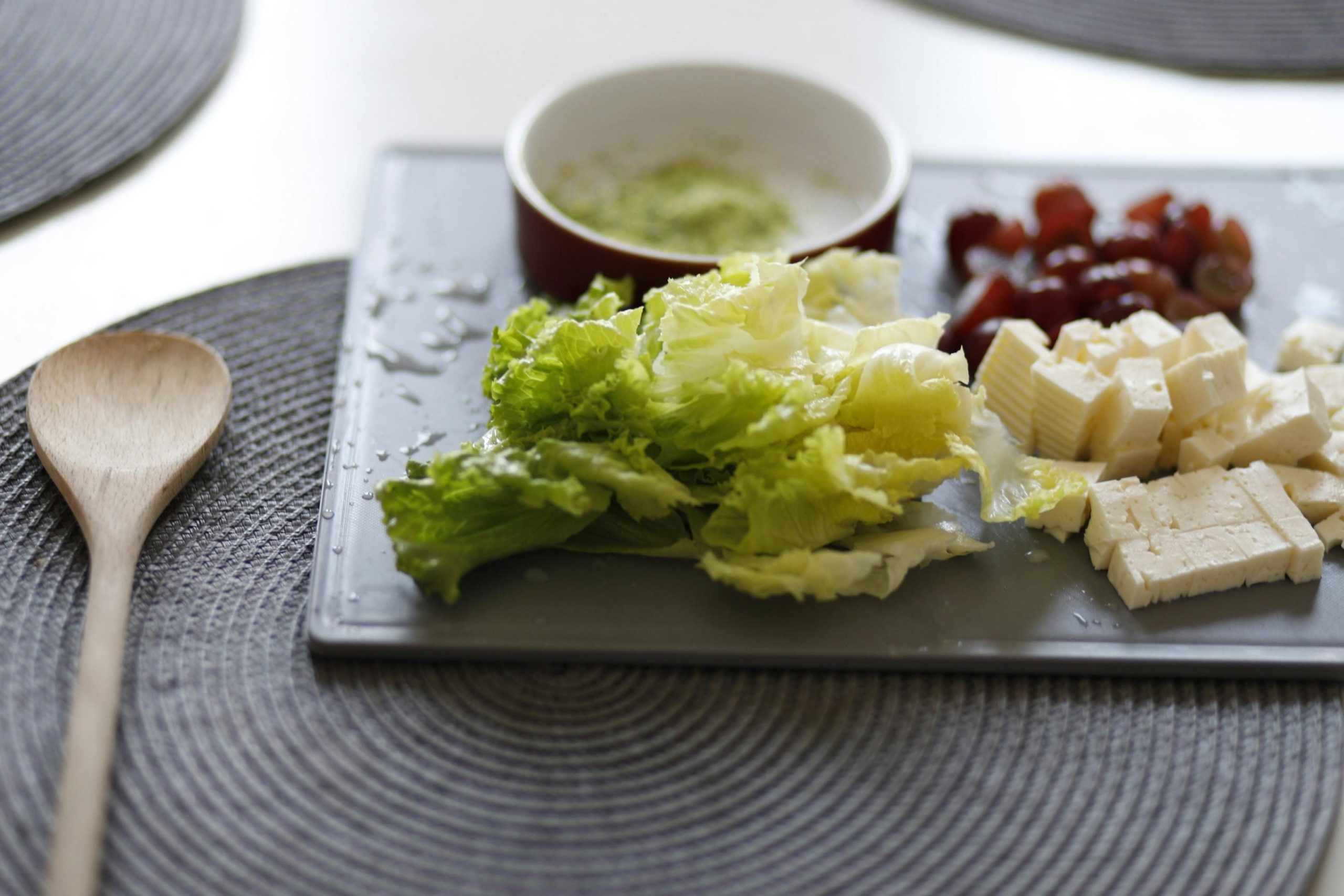Ever wondered how to make healthy eating not just a habit but a delight?
Many people struggle with incorporating nutritious meals into their daily lives because they think healthy food can’t be tasty.
Offering a variety of healthy cooking classes, from plant-based diets to gluten-free and keto options, can transform this misconception and show that healthy meals can also be delicious and satisfying.
This blog will explore diverse workshops, meal types, and the benefits of virtual cooking classes, alongside tackling common challenges and providing essential resources to help you master healthy cooking.
Diverse Workshops to Spice Up Your Healthy Cooking Classes

To keep your healthy cooking classes engaging and appealing, consider diversifying the workshop themes. Interactive workshops such as ‘Farm to Table’ experiences or ‘Global Flavours’ sessions not only educate but also immerse participants in a broader culinary world. These workshops can provide hands-on experience with unique ingredients and cooking techniques, which is invaluable for those looking to expand their culinary horizons. By integrating a variety of themes, you cater to a wider audience and keep the content fresh and exciting.
Another effective approach is to incorporate seasonal and local ingredients into your cooking classes. This not only supports local farmers and promotes sustainability but also teaches participants how to make the most of what’s available during different times of the year. For instance, a summer workshop might focus on light salads and fresh fruits, while a winter session could explore hearty soups and root vegetables. This seasonal approach helps participants learn how to adapt their cooking based on availability and encourages creativity in the kitchen.
Lastly, don’t underestimate the power of themed cooking challenges or competitions within your workshops. These can make learning fun and foster a sense of community among participants. Whether it’s a contest to create the best dish using a specific ingredient or a team challenge to prepare a meal under time constraints, these activities can enhance learning through direct engagement and a bit of friendly competition. Such dynamic and participative formats not only make the classes more memorable but also help reinforce the cooking skills and knowledge imparted during the session.
Meal Types to Focus on in Healthy Cooking Classes

In healthy cooking classes, focusing on a variety of meal types can cater to the diverse needs and interests of participants. Breakfast classes might include smoothies and overnight oats, teaching the importance of starting the day with a nutritious meal. Lunch sessions could focus on quick, easy-to-prepare dishes like wraps or salads that are perfect for busy lifestyles. For dinner, instructors can demonstrate how to prepare balanced meals that include proteins, vegetables, and whole grains, showing how a wholesome dinner can support overall health and well-being.
Additionally, don’t overlook the importance of snacks in maintaining energy levels throughout the day. Healthy cooking classes can provide great insights into preparing nutritious snacks such as homemade granola bars, fruit compotes, or vegetable dips. These classes can teach participants about the nutritional value of various snack options and how to make them both healthy and delicious. By covering a range of meal types, from main courses to snacks, these classes can equip individuals with the skills to manage their diet effectively throughout the day.
Embracing Virtual Healthy Cooking Classes
Embracing virtual healthy cooking classes can significantly extend your reach, allowing participants from different geographical locations to join. These classes offer the flexibility of learning from home, which can be particularly appealing to those with tight schedules. To ensure these online classes are effective, it’s important to choose recipes that require minimal special equipment and are easy to follow. This makes the cooking process more accessible to everyone, regardless of their kitchen setup or cooking level.
Moreover, to keep virtual classes interactive, it’s crucial to encourage participant engagement through live Q&A sessions, polls, or sharing food photos for feedback. This interaction replicates the communal aspect of in-person classes and keeps the learning experience lively and engaging. Offering supplementary materials like recipe cards or instructional videos can also enhance the learning experience, ensuring that participants can revisit the content anytime to refine their skills or recreate the dishes.
Overcoming Challenges in Healthy Cooking Education
Teaching healthy cooking can be challenging, especially when students face barriers like limited access to specific ingredients or dietary restrictions. To overcome these hurdles, it’s essential to offer flexible recipes that can adapt to different needs and availability. For instance, if a recipe calls for a certain type of fresh produce that might not be accessible year-round, suggest alternatives that maintain the nutritional integrity of the dish. This approach not only makes healthy cooking more inclusive but also educates participants on the versatility of ingredients.
Another significant challenge is keeping participants engaged, particularly in a learning environment that may initially seem restrictive due to health-oriented guidelines. To tackle this, educators can incorporate interactive elements such as taste tests or ingredient quizzes. These activities not only make the learning process more enjoyable but also deepen the participants’ understanding of the food they are preparing. Here are a few engagement strategies:
- Interactive quizzes on nutritional content
- Group challenges that encourage teamwork
- Taste tests to compare different ingredients
Addressing dietary restrictions effectively requires a well-prepared instructor who can offer substitutions and explain the nutritional impact of each alternative. This ensures that all participants, regardless of their dietary needs, can partake fully in the classes. It’s also beneficial to provide participants with handouts or digital content summarizing the key points from the class, including substitution lists and the health benefits of specific ingredients, which they can refer to later.
Essential Resources for Successful Healthy Cooking Classes
Essential resources for successful healthy cooking classes include a well-equipped kitchen and access to a comprehensive recipe database. Ensure that the kitchen is stocked with basic tools like knives, cutting boards, blenders, and cookware suitable for various cooking methods such as baking, steaming, and grilling. Additionally, having a digital or physical recipe database allows participants to explore a variety of healthy recipes and encourages them to try these dishes at home. This resource should be regularly updated to reflect seasonal ingredients and the latest nutritional guidelines.
Beyond physical resources, having expert guidance available can significantly enhance the learning experience. This might involve inviting nutritionists or dietitians to speak about the principles of healthy eating or experienced chefs to demonstrate advanced cooking techniques. Providing downloadable content, such as step-by-step cooking guides or nutritional information charts, can also add substantial value. These materials help students to continue their learning outside of class and apply their new skills in their everyday meal prep and diet planning.
Enhance Your Culinary Skills with INDULGE‘s Exclusive Experiences
INDULGE offers a distinctive blend of culinary tours and exclusive experiences that can significantly enhance your cooking skills. By participating in these tours, you’ll not only discover the rich culinary history of Zurich but also gain practical insights from local chefs. These experiences are designed to deepen your understanding of various cooking techniques and ingredients. For instance, during a guided food tour in Zurich West, you can learn about:
- The origins and preparation of traditional Swiss dishes like Zürcher Geschnetzeltes.
- The use of local ingredients in creating internationally inspired cuisine.
This practical knowledge is invaluable for anyone looking to broaden their culinary expertise and apply it in their own kitchen.
Beyond the tours, INDULGE‘s exclusive Wine & Dine experiences provide an opportunity to observe and learn from the best in the industry. These multi-course meals, prepared by skilled chefs, offer a deep dive into course cookery and the art of pairing food with the perfect wine. Here’s what you can look forward to:
- A curated selection of dishes that showcase the versatility of Swiss and international cuisines.
- Insights from chefs and sommeliers that can enhance your understanding of flavour profiles and culinary aesthetics.
By integrating these experiences into your learning journey, you not only enhance your cooking skills but also your ability to create and enjoy sophisticated meals. To explore and book your next culinary adventure with INDULGE, visit their website.
Frequently Asked Questions
What to cook in foods class?
In healthy cooking classes, you can focus on a variety of meal types including breakfast dishes like smoothies and overnight oats, lunch options such as wraps and salads, and balanced dinner meals that incorporate proteins, vegetables, and whole grains. Additionally, teaching how to prepare nutritious snacks like homemade granola bars and vegetable dips is also beneficial.
How can I improve my cooking class?
To improve your cooking class, consider diversifying the workshop themes, using interactive and participative formats like cooking challenges, and incorporating seasonal and local ingredients. Also, for virtual classes, ensure recipes are easy to follow with minimal special equipment, and enhance interaction through live Q&A sessions and sharing of food photos for feedback. Providing supplementary materials like recipe cards or instructional videos can also enhance the learning experience.








